How to Understand the Significance of the Temperament of White Shepherds:
Hello, dog lovers today I will explain about Temperament of White Shepherds.
White Shepherds are awesome dogs. They’re like the super smart cousins of German Shepherds but with a stunning white coat. When it comes to personality, they’re top-notch. They’re super loyal, always ready to learn new tricks, and they love being around their family. Plus, they’re great at protecting their people. Whether it’s playing fetch in the yard or keeping an eye out for intruders, they’re always on it. So, if you’re looking for a furry friend who’s both clever and lovable, White Shepherds are the way to go.
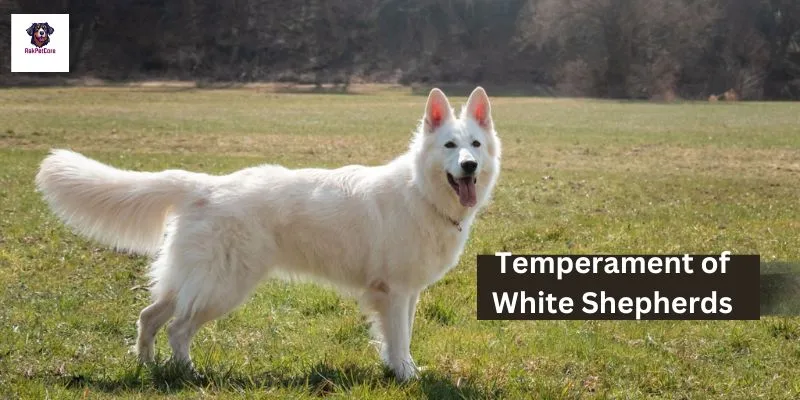
firstly Understand the Loyalty of White Shepherds:
White Shepherds are renowned for their loyalty, forming deep bonds with their family members that are truly special. Let’s take a closer look at what makes them so devoted.
- Deep Bonds with Family Members: White Shepherds aren’t just pets; they’re part of the family. From the moment they join your household, they begin forging strong connections with each member. They have this remarkable ability to sense emotions and understand when someone needs comfort or companionship. Whether it’s cuddling on the couch, accompanying you on walks, or simply being present, White Shepherds are there for their loved ones through thick and thin.
- Protective Instincts in Action: One of the most striking aspects of White Shepherds’ loyalty is their protective instincts. They take their role as guardians seriously and will do whatever it takes to keep their family safe. From alerting you to potential dangers to standing by your side in unfamiliar situations, White Shepherds demonstrate unwavering loyalty and bravery. Their mere presence can provide a sense of security and peace of mind, knowing that they’re watching over you with unwavering devotion.
- Loyalty in Everyday Life: Stories from White Shepherd Owners: Countless stories from White Shepherd owners illustrate just how loyal these dogs truly are. Take Sarah, for example, who recalls how her White Shepherd, Luna, never left her side during a difficult time. Luna would curl up next to her when she was feeling down, offering silent support and reassurance. Then there’s Mark, whose White Shepherd, Max, displayed remarkable loyalty by bravely defending the family against a potential threat, proving that his loyalty knows no bounds.
In essence, the loyalty of White Shepherds goes beyond mere companionship; it’s a heartfelt commitment to being there for their family members in good times and bad. Their unwavering devotion and protective instincts make them cherished members of the family, enriching the lives of those lucky enough to have them by their side.
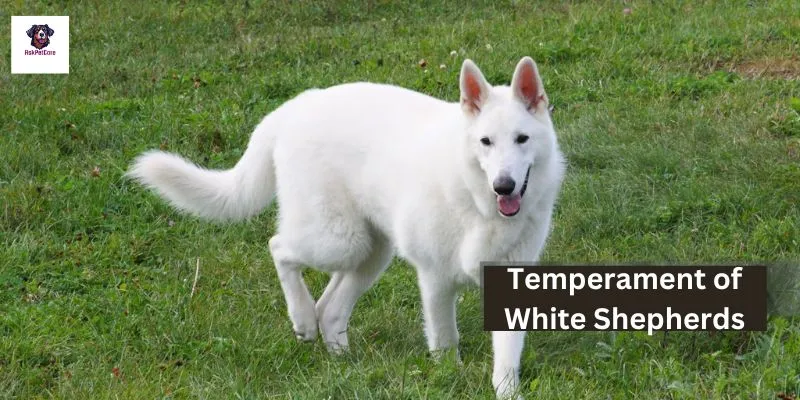
Now Understand The Intelligence Of White Shepherds :
White Shepherds are not only incredibly loyal but also highly intelligent dogs. Let’s take a closer look at what makes them such smart companions.
- Quick Learners: Their Capacity for Training White Shepherds is like sponges when it comes to learning new tricks and commands. From simple tasks like sit and stay to more complex behaviors like fetching the newspaper or even opening doors, they pick up on commands quickly and eagerly. Their sharp minds and eagerness to please make training sessions a breeze for both pet parents and their furry friends. With consistency, patience, and positive reinforcement, White Shepherds can master a wide range of skills, making them perfect partners in crime for various activities and sports.
- Problem-Solving Abilities: Examples of Their Intelligence in Practice White Shepherds’ intelligence isn’t just limited to obedience training; they’re also excellent problem solvers. When faced with challenges or puzzles, they’ll put their thinking caps on and work tirelessly to find a solution. Whether it’s figuring out how to reach a toy hidden under the couch or navigating through a new environment, White Shepherds approach problems with determination and creativity. Their ability to think on their feet and adapt to different situations is truly impressive and showcases their remarkable intellect.
- Mental Stimulation: Keeping White Shepherds Sharp and Engaged To keep White Shepherds mentally sharp and engaged, it’s essential to provide them with plenty of mental stimulation. This can include interactive toys, puzzle games, and agility training. Engaging in activities that challenge their minds not only prevents boredom but also strengthens their cognitive abilities. Whether it’s a game of hide-and-seek with treats or a training session to learn a new trick, White Shepherds thrive on mental stimulation and will appreciate the opportunity to showcase their intelligence.
In summary, White Shepherds’ intelligence sets them apart as exceptional companions. Their quick learning abilities, problem-solving skills, and need for mental stimulation make them not only loyal but also intellectually stimulating pets. By providing them with opportunities to learn and grow, pet parents can unlock the full potential of their White Shepherd’s brilliant mind.

Now Understands The Energetic Nature Of White Shepherds:
White Shepherds are known for their boundless energy and zest for life. Let’s explore how to embrace and manage their energetic nature to ensure they lead happy and healthy lives.
- Daily Exercise Requirements: What to Expect White Shepherds have high exercise needs and thrive on daily physical activity. On average, they require at least 1-2 hours of exercise each day to keep them mentally stimulated and physically fit. This can include activities like brisk walks, runs, hikes, and playtime in a fenced yard. Regular exercise not only helps burn off their excess energy but also prevents boredom and destructive behaviors.
- Activities to Keep Them Happy and Healthy: To keep White Shepherds happy and healthy, it’s essential to provide them with a variety of stimulating activities. Interactive games such as fetch, tug-of-war, and agility courses are excellent ways to engage their minds and bodies. Additionally, enrolling them in obedience training classes or canine sports like agility, rally, or flyball can provide both mental and physical challenges. Swimming is another fantastic activity that many White Shepherds enjoy and provides a low-impact workout for their joints.
- Channeling Their Energy: Tips for Managing Their Enthusiasm Managing the enthusiasm of a White Shepherd requires a combination of exercise, mental stimulation, and structured routines. Here are some tips for channeling their energy effectively:
- Establish a consistent exercise schedule: Stick to a daily routine of physical activity to help burn off excess energy and maintain a balanced lifestyle.
- Provide mental stimulation: Engage their minds with puzzle toys, training sessions, and interactive games to prevent boredom and destructive behaviors.
- Teach impulse control: Practice obedience training exercises such as sit-stay and leave it to help them learn self-control and focus their energy on positive behaviors.
- Use positive reinforcement: Reward good behavior with praise, treats, or playtime to reinforce desired behaviors and encourage them to repeat them in the future.
- Be patient and consistent: Managing the energy of a White Shepherd requires patience and consistency. Stay committed to their exercise and training regimen, and you’ll reap the rewards of a happy, well-behaved companion.
In summary, embracing the energetic nature of White Shepherds involves meeting their daily exercise requirements, providing stimulating activities, and effectively managing their enthusiasm through structured routines and positive reinforcement. With the right approach, White Shepherds can thrive both physically and mentally, leading fulfilling lives as cherished family members.

Now Understand The Alertness Of White Shepherds :
Let’s delve into what makes them so vigilant and how to strike a balance between their alertness and relaxation.
- Natural Watchdogs: Their Instincts for Protection White Shepherds have an innate instinct to protect their family and territory. Whether it’s a stranger approaching the house or a suspicious noise in the night, they’re quick to alert their owners to any potential threats. This protective instinct is deeply ingrained in their nature and stems from their history as herding and guarding dogs. With their acute senses and strong intuition, White Shepherds excel at detecting even the slightest changes in their environment and reacting swiftly to ensure the safety of their loved ones.
- Alertness in Action: Real-Life Scenarios Countless real-life stories showcase the alertness of White Shepherds in action. Take, for instance, the tale of Jack, whose White Shepherd, Bella, alerted him to a fire in the kitchen by barking incessantly until he woke up and investigated. Thanks to Bella’s quick thinking and vigilance, Jack was able to extinguish the fire before it caused any serious damage. Then there’s Sarah, whose White Shepherd, Max, alerted her to a stranger lurking around the neighborhood late at night, allowing her to take precautions and ensure her safety. These stories are just a few examples of how White Shepherds’ alertness can be a lifesaver in critical situations.
- Strike a Balance: Finding Harmony Between Vigilance and Relaxation While White Shepherds’ alertness is undoubtedly valuable, it’s essential to strike a balance between their vigilance and relaxation. Constant vigilance can lead to stress and anxiety if not managed properly. Providing them with opportunities to unwind and relax is crucial for their overall well-being. This can include quiet downtime at home, soothing massages, and engaging in calming activities like gentle walks or cuddle sessions. By fostering a sense of security and tranquility in their environment, you can help White Shepherds maintain a healthy balance between alertness and relaxation, allowing them to be vigilant protectors while also enjoying moments of peace and contentment.
In summary, the alertness of White Shepherds is a remarkable trait that enhances their role as loyal protectors. By recognizing their natural instincts, appreciating their vigilant behavior, and fostering a sense of balance in their lives, pet parents can ensure that White Shepherds fulfill their protective duties while also enjoying a fulfilling and relaxed lifestyle.

Now Embracing the Gentle Side of White Shepherd:
White Shepherds may be known for their strength and intelligence, but they also have a gentle and loving side that makes them wonderful companions. Let’s explore what makes them so affectionate and how they interact with children, other pets, and their human family.
- Affectionate Companions: Their Loving Nature White Shepherds are incredibly affectionate dogs who thrive on love and companionship. They have a deep bond with their human family members and enjoy nothing more than spending time by their side, whether it’s cuddling on the couch, going for walks, or simply being present. Their gentle demeanor and wagging tails are a testament to their loving nature, and they never hesitate to shower their loved ones with kisses and affectionate gestures.
- Interaction with Children and Other Pets: What to Expect When it comes to children and other pets, White Shepherds are known for their patience and gentle demeanor. They are naturally protective of their younger family members and often take on the role of a loving guardian. Whether it’s playing gently with children, watching over them as they sleep, or patiently tolerating the antics of other pets, White Shepherds excel at forming harmonious relationships within the family unit. However, it’s essential to supervise interactions between White Shepherds and young children to ensure everyone’s safety and well-being.
- The Gentle Giant: Stories of White Shepherds’ Heartwarming Moments White Shepherds have a knack for melting hearts with their heartwarming gestures and acts of kindness. Take, for example, the story of Emma, whose White Shepherd, Rocky, would gently nudge her elderly grandmother’s hand whenever she was feeling down, bringing a smile to her face and brightening her day. Then there’s the tale of Max, who became best friends with the family cat and would often cuddle up with him for afternoon naps, showcasing the gentle and accepting nature of White Shepherds towards other animals.
In summary, the gentle side of White Shepherds is a cherished aspect of their personality that makes them beloved companions. Whether they’re cuddling with their human family, playing with children, or forming bonds with other pets, White Shepherds exemplify the qualities of kindness, gentleness, and unconditional love. Their heartwarming moments and affectionate gestures are a true testament to the special bond they share with their human counterparts.

Now Exploring The Sociable Side Of White Shepherds :
White Shepherds are not just loyal and intelligent; they’re also quite sociable dogs. Here’s a closer look at how they interact with others and what shapes their social behavior:
- Socialization: Building Confidence and Friendliness Socialization plays a crucial role in shaping the sociable nature of White Shepherds. From a young age, exposing them to various people, animals, environments, and experiences helps build their confidence and friendliness. Positive interactions during puppyhood lay the foundation for a well-adjusted and sociable adult dog. Through regular outings, visits to the dog park, puppy classes, and playdates with other dogs, White Shepherds learn to navigate social situations with ease and develop strong social skills.
- Interactions with Strangers: Their Approach and Behavior When it comes to strangers, White Shepherds typically approach with a combination of curiosity and caution. While they are naturally protective of their family and territory, they are also capable of being friendly and accepting towards unfamiliar people. White Shepherds may initially be reserved or aloof around strangers, taking their time to assess the situation before warming up to new individuals. With proper socialization and positive experiences, they can learn to greet strangers politely and with confidence, showcasing their sociable nature.
- Social Butterfly or Lone Wolf: Understanding Their Social Preferences White Shepherds, like humans, have individual personalities and social preferences. Some may be outgoing and sociable, eagerly engaging with everyone they meet and thriving in social settings. Others may be more reserved and selective in their interactions, preferring the company of familiar faces and close family members. Understanding your White Shepherd’s unique social preferences is key to ensuring they feel comfortable and secure in various social situations. Whether they’re a social butterfly or a bit of a lone wolf, respecting their boundaries and providing opportunities for positive socialization will help them flourish and lead fulfilling lives.
In summary, White Shepherds are naturally sociable dogs who benefit from early socialization and positive experiences. Their interactions with strangers are often a mix of curiosity and caution, and their social preferences vary from dog to dog. By fostering a supportive and enriching social environment, pet parents can help White Shepherds develop strong social skills and enjoy meaningful connections with both humans and animals alike.
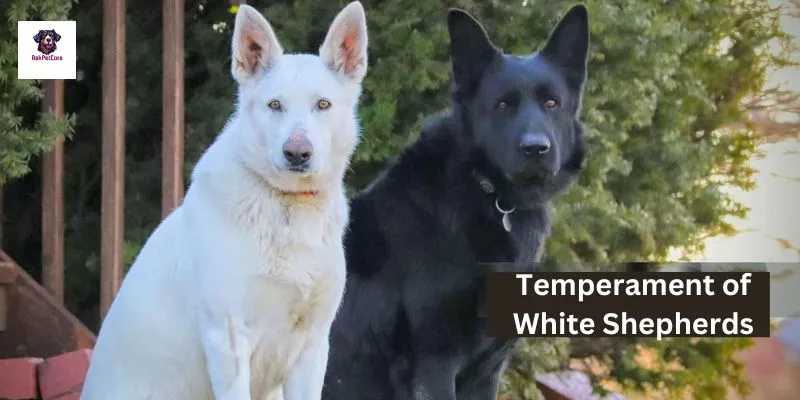
If you like to read more about German shepherds read my these articles:
german-shepherd-weight-kg-guide-tips-for-owners:
german-shepherd-colors-best-20-worldwide-colors:
Now Unveiling the Playful Spirit of White:
White Shepherds are not only loyal and intelligent but also incredibly playful dogs. Here’s a closer look at what brings out their playful side and how they express their joy through play:
- Playtime Essentials: Toys and Activities They Love When it comes to playtime, White Shepherds have a few favorite toys and activities that never fail to bring them joy. Interactive toys like balls, tug ropes, and puzzle toys are great for engaging their minds and keeping them entertained. They also enjoy games of fetch, where they can show off their impressive speed and agility. Outdoor activities like hiking, running, and swimming are also favorite pastimes for White Shepherds, allowing them to burn off energy and explore the great outdoors.
- Playful Behaviors: From Zoomies to Tail Wagging White Shepherds have a repertoire of playful behaviors that never fail to bring a smile to their owners’ faces. From zooming around the house at lightning speed (aptly known as “zoomies”) to excitedly wagging their tails and bouncing around with enthusiasm, their playful antics are a joy to behold. They may also engage in playful barking, jumping, and pouncing, expressing their exuberance and zest for life in everything they do.
- Finding Joy in Play: Stories of White Shepherds’ Playful Antics Countless stories from White Shepherd owners highlight the playful spirit and antics of these delightful dogs. Take, for example, the tale of Max, whose White Shepherd, Luna, would eagerly chase after her favorite ball for hours on end, her tail wagging furiously with each successful retrieval. Then there’s the story of Bella, who would playfully splash around in the backyard kiddie pool on hot summer days, delighting in the cool water and bringing laughter to her family’s faces. These heartwarming stories serve as a testament to the joy and happiness that White Shepherds bring through their playful antics.
In summary, the playful spirit of White Shepherds is an integral part of their personality that adds warmth, laughter, and fun to any household. Whether they’re chasing after toys, romping around with their favorite playmates, or simply enjoying the great outdoors, White Shepherds find pure joy in every moment of play. Their exuberance and zest for life are infectious, making them cherished companions for families of all ages.
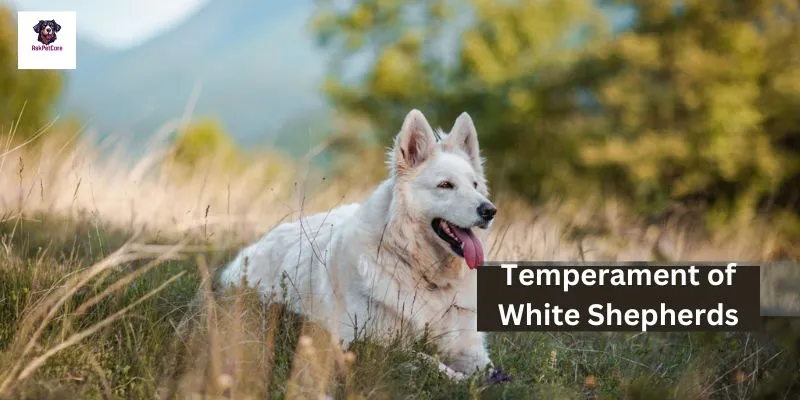
How to Understand Temperament of White Shepherds Language:
White Shepherds may not speak our language, but they communicate with us in their unique ways. Here’s how to understand their vocalizations, body language, and build a stronger bond through effective communication:
- Vocalizations: Barks, Whines, and Howls White Shepherds use a variety of vocalizations to express themselves and communicate with their humans. Barking is their most common form of vocalization and can signify anything from excitement and playfulness to alertness and protection. They may also whine or whimper to indicate discomfort, anxiety, or a desire for attention. Howling is another vocalization you may hear from White Shepherds, often in response to certain sounds or as a form of communication with other dogs. By paying attention to the context and frequency of their vocalizations, you can better understand what your White Shepherd is trying to tell you.
- Body Language: Reading Their Signals and Cues White Shepherds are masters of body language and use subtle cues to convey their thoughts and emotions. Pay attention to their posture, facial expressions, and tail movements to decipher what they’re trying to communicate. A relaxed and wagging tail usually indicates happiness and contentment, while a stiff or lowered tail may signal fear or aggression. Likewise, a relaxed body posture with ears forward signifies curiosity or interest, while flattened ears and tense muscles may indicate discomfort or anxiety. By observing and interpreting their body language, you can gain valuable insights into your White Shepherd’s state of mind and respond accordingly.
- Building a Stronger Bond: Effective Communication Tips for Pet Parents Effective communication is key to building a strong bond with your White Shepherd. Here are some tips to enhance communication and deepen your connection:
- Establish clear and consistent cues: Use verbal commands and hand signals to communicate with your White Shepherd, and be consistent in your training methods.
- Practice active listening: Pay attention to your White Shepherd’s vocalizations and body language, and respond empathetically to their needs and emotions.
- Use positive reinforcement: Reward desired behaviors with praise, treats, or playtime to reinforce good communication and strengthen your bond.
- Spend quality time together: Engage in activities that you both enjoy, such as walks, play sessions, and cuddle time, to foster trust and mutual understanding.
- Be patient and understanding: Building a strong bond takes time and patience, so be patient with your White Shepherd and approach communication with kindness and empathy.
In summary, understanding White Shepherds’ communication involves paying attention to their vocalizations, body language, and building a strong bond through effective communication. By listening attentively, interpreting their cues, and responding with empathy, you can strengthen your connection with your White Shepherd and build a relationship based on trust, understanding, and mutual respect.
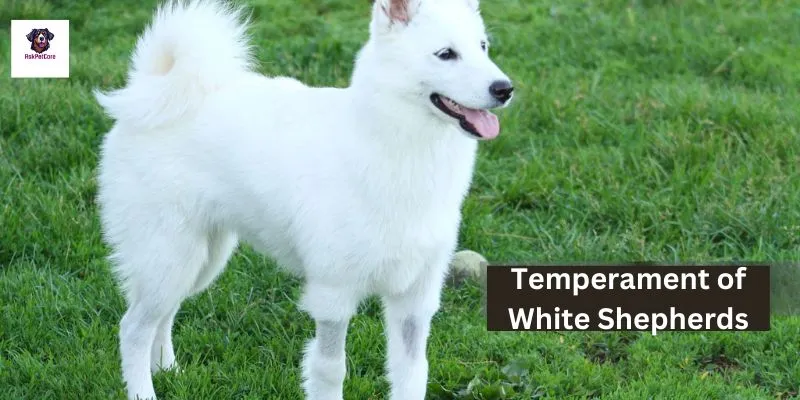
Now understand how to Deal with Separation Anxiety in White Shepherds :
Separation anxiety can be challenging for both White Shepherds and their owners, but with patience and understanding, it can be managed effectively. Here’s how to recognize the signs, prevent it, and seek help when needed:
- Recognizing the Signs: Symptoms of Separation Anxiety White Shepherds are known for their strong bonds with their human family members, which can sometimes lead to separation anxiety when left alone. Signs of separation anxiety may include:
- Excessive barking, whining, or howling when left alone.
- Destructive behaviors such as chewing furniture or digging.
- Pacing or restlessness.
- Urination or defecation indoors, even if they’re house-trained.
- Excessive drooling or panting.
- Attempts to escape or damage doors or windows.
Recognizing these signs is the first step in addressing separation anxiety and helping your White Shepherd feel more comfortable when left alone.
- Prevention and Management Strategies: Preventing and managing separation anxiety in White Shepherds involves a combination of training, desensitization, and providing them with a comforting environment. Here are some strategies to consider:
- Gradually acclimate your White Shepherd to being alone by starting with short absences and gradually increasing the duration over time.
- Provide plenty of mental and physical exercise to help them expend excess energy and reduce stress.
- Create a safe and comfortable space for your White Shepherd to relax in when you’re away, such as a cozy crate or designated area with their favorite toys and bedding.
- Use calming aids such as pheromone diffusers, calming music, or interactive toys to help alleviate anxiety when left alone.
- Avoid making a big deal out of arrivals and departures to prevent reinforcing anxious behaviors.
- Consider enlisting the help of a professional dog trainer or behaviorist to develop a customized treatment plan for your White Shepherd.
- Seeking Professional Help: When to Consult a Veterinarian or Trainer If your White Shepherd’s separation anxiety persists despite your best efforts, it may be time to seek professional help. A veterinarian can rule out any underlying medical conditions that may be contributing to their anxiety and recommend medication or supplements to help manage symptoms. Additionally, a certified dog trainer or behaviorist can provide guidance and support in implementing behavior modification techniques to address separation anxiety effectively.
In summary, dealing with separation anxiety in White Shepherds involves recognizing the signs, implementing prevention and management strategies, and seeking professional help when needed. With patience, consistency, and support, you can help your White Shepherd feel more secure and comfortable when left alone, leading to a happier and healthier relationship for both of you.
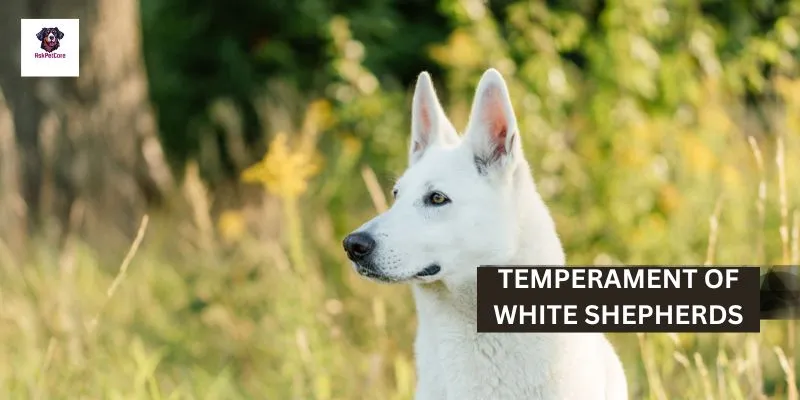
How Embracing the Aging Process: Caring for Senior White:
As White Shepherds age, they may require extra care and attention to ensure they remain comfortable and happy. Here’s how to embrace the aging process and provide the best possible care for your senior companion:
- Changes in Behavior and Health: What to Expect as White Shepherds get older, they may experience changes in their behavior and health. Common signs of aging in senior White Shepherds may include:
- Decreased energy levels and stamina.
- Joint stiffness or arthritis.
- Changes in appetite or weight.
- Increased frequency of accidents indoors.
- Cognitive decline or confusion.
- Reduced hearing or vision.
- Slower response times and decreased activity levels.
Recognizing these changes early on can help you provide appropriate care and support for your senior White Shepherd as they age.
- Providing Comfort and Support: Adjusting Their Environment to help your senior White Shepherd remain comfortable and content as they age, consider making adjustments to their environment. This may include:
- Providing a soft and supportive bed to help cushion their joints and provide relief from arthritis pain.
- Installing ramps or steps to help them navigate stairs or furniture more easily.
- Ensuring their food and water dishes are easily accessible and at a comfortable height.
- Keeping their living area clean and free of obstacles to prevent accidents and falls.
- Providing plenty of mental stimulation and gentle exercise to keep their minds sharp and bodies active.
- Monitoring their health closely and scheduling regular check-ups with their veterinarian to address any age-related health concerns promptly.
- Cherishing Every Moment: Stories of Love and Devotion with Senior White Shepherds Many pet owners find that their bond with their senior White Shepherd grows even stronger with age, as they cherish the moments spent together and appreciate the love and companionship their furry friend provides. Whether it’s enjoying leisurely walks in the park, cuddling on the couch, or simply being present, senior White Shepherds have a way of warming their owners’ hearts and reminding them of the preciousness of every moment.
In summary, caring for senior White Shepherds involves understanding the changes they may experience as they age, providing comfort and support through environmental adjustments, and cherishing the special moments shared with them. With love, patience, and attentive care, you can help your senior White Shepherd enjoy their golden years to the fullest and continue to be a cherished member of your family for years to come.
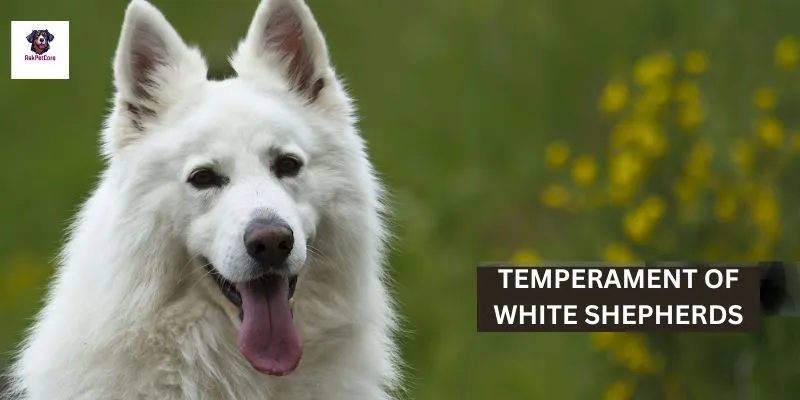
Conclusion:
- As we conclude our journey through the temperament of White Shepherds, we hope this guide has provided valuable insights for pet parents.
- Whether you’re welcoming a new White Shepherd into your family or already have one by your side, understanding their unique personality traits is key to fostering a strong and fulfilling bond.
- Remember, each White Shepherd is a special companion deserving of love, care, and understanding throughout every stage of life.
Five commonly searched questions about the temperament of White Shepherds:
Q: Are White Shepherds good family dogs?
Yes, White Shepherds are excellent family dogs known for their loyalty, intelligence, and gentle nature.
Q: Do White Shepherds get along with children?
Generally, yes. White Shepherds tend to be patient and gentle with children when properly socialized and supervised.
Q: Are White Shepherds aggressive?
White Shepherds are not inherently aggressive, but like any dog breed, their behavior can be influenced by factors such as genetics, training, and socialization.
Q: Do White Shepherds bark a lot?
White Shepherds can be vocal dogs and may bark to communicate, but excessive barking can often be mitigated through proper training and socialization.
Q: Are White Shepherds good guard dogs?
Yes, White Shepherds have strong protective instincts and can make excellent guard dogs when trained and socialized properly. They are loyal and alert, making them vigilant protectors of their families and homes.
Here are some reference books that are considered authoritative on the topic of dog care, including nail care:
- “The Complete Dog Owner’s Manual” by Dr. Bruce Fogle
- “The Ultimate Guide to Dog Care: Everything You Need to Know to Keep Your Dog Happy and Healthy” by Amy Marder and Andrew Luescher
- “The Veterinarians’ Guide to Natural Remedies for Dogs: Safe and Effective Alternative Treatments and Healing Techniques from the Nations Top by Martin Zucker
Disclaimer: I hope you will be satisfied if still have any queries contact me. thanks. This is my personal information you must contact your vet for more.
